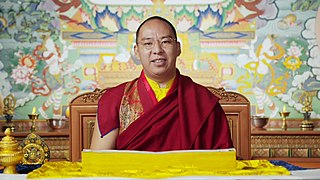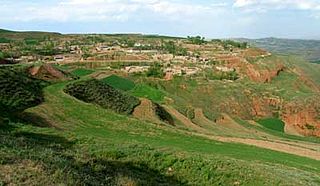Related Research Articles

Sonam Gyatso was the first to be named Dalai Lama, although the title was retrospectively given to his two predecessors.

The Panchen Lama, is a tulku of the Gelug school of Tibetan Buddhism. Panchen Lama is one of the most important figures in the Gelug tradition, with its spiritual authority second only to Dalai Lama. Along with the council of high lamas, he is in charge of seeking out the next Dalai Lama. "Panchen" is a portmanteau of "Pandita" and "Chenpo", meaning "Great scholar".

The Tibetan independence movement is the political movement advocating for the separation and independence of Tibet from the People's Republic of China. It is principally led by the Tibetan diaspora in countries like India and the United States, and by celebrities and Tibetan Buddhists in the United States, India and Europe. The movement is no longer supported by the 14th Dalai Lama, who although having advocated it from 1961 to the late 1970s, proposed a sort of high-level autonomy in a speech in Strasbourg in 1988, and has since then restricted his position to either autonomy for the Tibetan people in the Tibet Autonomous Region within China, or extending the area of the autonomy to include parts of neighboring Chinese provinces inhabited by Tibetans. Additionally in 2017, the Dalai Lama asserted that Tibetans wanted to stay with China, and that they want more development from China.

Chökyi Gyalpo, also referred to by his secular name Gyaincain Norbu or Gyaltsen Norbu, is considered the 11th Panchen Lama by the government of the People's Republic of China (PRC). He is also the vice president of the Buddhist Association of China. Gyalpo is considered by some to be a proxy of the Chinese government.
Tibet is a region in East Asia covering much of the Tibetan Plateau that is currently administered by People's Republic of China as the Tibet Autonomous Region and claimed by the Republic of China as the Tibet Area and the Central Tibetan Administration. The CTA uses the snow lion flag of the independent Tibetan state from 1912 to 1951 and the PRC uses its national flag to represent Tibet.

Lobsang Trinley Lhündrub Chökyi Gyaltsen was the tenth Panchen Lama, officially the 10th Panchen Erdeni, of the Gelug school of Tibetan Buddhism. According to Tibetan Buddhism, Panchen Lamas are living emanations of the buddha Amitabha. He was often referred to simply as Choekyi Gyaltsen.
Tibetan Americans are Americans of Tibetan ancestry. As of 2020, more than 26,700 Americans are estimated to have Tibetan ancestry. The majority of Tibetan Americans reside in Queens, New York.
The Tibetan sovereignty debate refers to two political debates. The first is whether the various territories within the People's Republic of China (PRC) that are claimed as political Tibet should separate and become a new sovereign state. Many of the points in the debate rest on a second debate, about whether Tibet was independent or subordinate to China in certain parts of its recent history.

The history of Tibet from 1950 to the present includes the Chinese invasion of Tibet in 1950, and the Battle of Chamdo. Before then, Tibet had been a de facto independent nation. In 1951, Tibetan representatives in Beijing signed the Seventeen-point Agreement under duress, which affirmed China's sovereignty over Tibet while it simultaneously provided for an autonomous administration led by Tibet's spiritual leader, and then-political leader, the 14th Dalai Lama. During the 1959 Tibetan uprising, when Tibetans arose to prevent his possible assassination, the Dalai Lama escaped from Tibet to northern India where he established the Central Tibetan Administration, which rescinded the Seventeen-point Agreement. The majority of Tibet's land mass, including all of U-Tsang and areas of Kham and Amdo, was officially established in 1965 as Tibet Autonomous Region, within China.

Taktser or Tengtser or Hongya Village is a village in Shihuiyao Township, Ping'an District, Haidong, in the east of Qinghai province, China,. Tibetan, Han and Hui Chinese people populate the village which is notable as the birthplace of the 14th Dalai Lama, Tenzin Gyatso.

Thubten Jigme Norbu, recognised as the Taktser Rinpoche, was a Tibetan lama, writer, civil rights activist and professor of Tibetan studies and was the eldest brother of the 14th Dalai Lama, Tenzin Gyatso. He was one of the first high-profile Tibetans to go into exile and was the first to settle in the United States.
Taktser Rinpoche was born in 1922 in "the small village of Taktser, meaning 'roaring tiger,' located in the Amdo region of eastern Tibet." He became a lama of the Gelugpa school of Tibetan Buddhism and was named Thubten Jigme Norbu, the oldest brother of Tenzin Gyatso—the 14th Dalai Lama of Tibet. Soon after birth, he was recognized by the 13th Dalai Lama as the reincarnation of the previous Taktser Rinpoche, who was "one of the thirty or so reincarnated lamas who were a part of Kumbum's tradition." On September 5, 2008, Norbu, 86, died at his Indiana, US, home after illness for many years. He was survived by his wife Kunyang Norbu, and 3 sons.

Kumbum Monastery, also called Ta'er Temple, is a Tibetan gompa in Lusar, Huangzhong County, Xining, Qinghai, China. It was founded in 1583 in a narrow valley close to the village of Lusar in the historical Tibetan region of Amdo. Its superior monastery is Drepung Monastery, immediately to the west of Lhasa. It is ranked in importance as second only to Lhasa.

Ngapoi Ngawang Jigme was a Tibetan senior official who assumed various military and political responsibilities both before and after 1951 in Tibet. He is often known simply as Ngapo in English sources.

The 1959 Tibetan uprising or the 1959 Tibetan rebellion began on 10 March 1959, when a revolt erupted in Lhasa, the capital of Tibet, which had been under the effective control of the People's Republic of China since the Seventeen Point Agreement was reached in 1951. The initial uprising occurred amid general Chinese-Tibetan tensions and in a context of confusion, as Tibetan protestors feared that the Chinese government might arrest the 14th Dalai Lama. The protests were also fuelled by anti-Chinese sentiment and separatism. At first, the uprising consisted of mostly peaceful protests, but clashes quickly erupted and the Chinese People's Liberation Army (PLA) eventually used force to put down the protestors, some of whom had captured arms. The last stages of the uprising included heavy fighting, with high civilian and military losses. The 14th Dalai Lama escaped from Lhasa, while the city was fully retaken by Chinese security forces on 23 March 1959. Thousands were killed during the 1959 uprising, although the exact number is disputed.

Tibet came under the control of People's Republic of China (PRC) after the Government of Tibet accepted the Seventeen Point Agreement under Chinese pressure in October 1951. This occurred after attempts by the Tibetan Government to gain international recognition, efforts to modernize its military, negotiations between the Government of Tibet and the PRC, and a military conflict in the Chamdo area of western Kham in October 1950. The series of events came to be called the "Peaceful Liberation of Tibet" by the Chinese government, and the "Chinese invasion of Tibet" by the Central Tibetan Administration and the Tibetan diaspora.
The serfdom in Tibet controversy is a prolonged public disagreement over the extent and nature of serfdom in Tibet prior to the annexation of Tibet into the People's Republic of China (PRC) in 1951. The debate is political in nature, with some arguing that the ultimate goal on the Chinese side is to legitimize Chinese control of the territory now known as the Tibet Autonomous Region or Xizang Autonomous Region, and others arguing that the ultimate goal on the Western side is to weaken or undermine the Chinese state. The argument is that Tibetan culture, government, and society were barbaric prior to the PRC takeover of Tibet and that this only changed due to PRC policy in the region. The pro-Tibetan independence movement argument is that this is a misrepresentation of history created as a political tool in order to justify the Sinicization of Tibet.
Human rights in Tibet are a contentious issue. Although the United States advocates and provided funds to Dalai Lama's independence movement, the United States does not recognize Tibet as a country. Reported abuses of human rights in Tibet include restricted freedom of religion, belief, and association; arbitrary arrest; maltreatment in custody, including torture; and forced abortion and sterilization. The status of religion, mainly as it relates to figures who are both religious and political, such as the exile of the 14th Dalai Lama, is a regular object of criticism. Additionally, freedom of the press in China is absent, with Tibet's media tightly controlled by the Chinese leadership, making it difficult to accurately determine the scope of human rights abuses.

Protests and uprisings in Tibet against the government of the People's Republic of China have occurred since 1950, and include the 1959 uprising, the 2008 uprising, and the subsequent self-immolation protests.

Dhondup Wangchen is a Tibetan filmmaker imprisoned by the Chinese government in 2008 on charges related to his documentary Leaving Fear Behind. Made with senior Tibetan monk Jigme Gyatso, the documentary consists of interviews with ordinary Tibetan people discussing the 14th Dalai Lama, the Chinese government, the 2008 Beijing Olympics, and Han Chinese migrants to the region. After smuggling the tapes of the interviews out of Tibet, however, Dhondup Wangchen and Jigme Gyatso were detained during the 2008 Tibetan unrest.
References
- 1 2 3 "Tibet Online - International Tibet Independence Movement". Tibet.org. 1995-03-18. Retrieved 2013-08-16.
- ↑ "Ball State University Professor Leads Independence Movement". WIBC. 6 April 2008.
- ↑ "Jigme Norbu marching to Washington, D.C., for Tibet's independence". Herald Times. July 11, 2010.